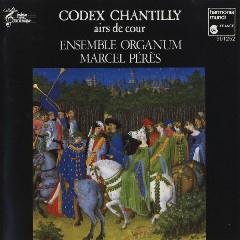Codex de Chantilly - Airs de Cour du XIV Siècle (1987)
Codex de Chantilly - Airs de Cour du XIV Siècle (1987)

1 –Cunelier Se Galaas Et Le Puissant Artus (Ballade, Fol. 38) 2 –Guido Dieux Gart (Rondeau, Fol. 25) 3 –Anonymous Sans Joie Avoir (Ballade, Fol. 23) 4 –Guido Or Voit Tout (Ballade, Fol. 25v) 5 –Anonymous Toute Clerté (Ballade, Fol. 13) 6 –Baude Cordier Tout Par Compas (Rondeau - Canon, Fol. 12) 7 –Baude Cordier Belle, Bonne, Sage (Rondeau, Fol. 11v) 8 –Goscalch En Nul Estat (Ballade, Fol. 39v) 9 –Jacob de Senleches La Harpe De Mellodie (Fol. 43v) 10 –Solage Fumeux Fume Par Fumée (Rondeau, Fol. 59) 11 –François Andrieu Armes, Amours (Double Ballade, Fol. 52) 12 –Anonymous Adieu Vous Di (Fol. 47) Ensemble Organum: Baritone Vocals – Josep Cabré (tracks: 1, 2, 4-6, 8, 10) Bass Vocals – François Fauché (tracks: 5, 10, 11) Countertenor Vocals – Gérard Lesne (tracks: 1, 2, 4, 6-8, 11) Tenor Vocals – Josep Benet (tracks: 1, 2, 4 to 8, 10, 11) Vielle – Nanneke Schaap Directed By, Harpsichord [Clavicythérium Émile Jobin] – Marcel Pérès
The Chantilly Codex is the pivotal music document of the 14th century and one of the monuments of medieval music. Many of the shadowy greats of early French composition--including Solage, Cordier, and Andrieu--are represented here. The music of the ars subtilior--the subtle art--is eccentric, whimsical, extravagant; it contains the widest diversity of emotion. The Ensemble Organum, directed by Marcel Pérès, performs these works with stylistic deftness. --Joshua Cody, ensembleorganum.blogspot.com
The Chantilly Codex, apparently compiled shortly before 1400, is easily the most famous manuscript of the Ars Subtilior. The bulk of the works apparently date from c.1370-95, with the possible exception of Baude Cordier's famous "puzzle" rondeaus added at the beginning of the manuscript. It has been suggested that Cordier (fl. 1384-1398) was the editor for the codex. The primary locations at which this music was written were the courts of the Antipope in Avignon and of Foix, both in southern France.
The items in the manuscript include some songs dating back to Machaut and his contemporaries, and then later pieces for which Machaut's most elaborate songs apparently served as inspiration. The rondeaus of Cordier are notated in the shape of a circle (track #9; canonic) and a heart (track #12) and represent this style at its most obscure. ---medieval.org
download (mp3 @192 kbs):
yandex mediafire ulozto gett bayfiles








